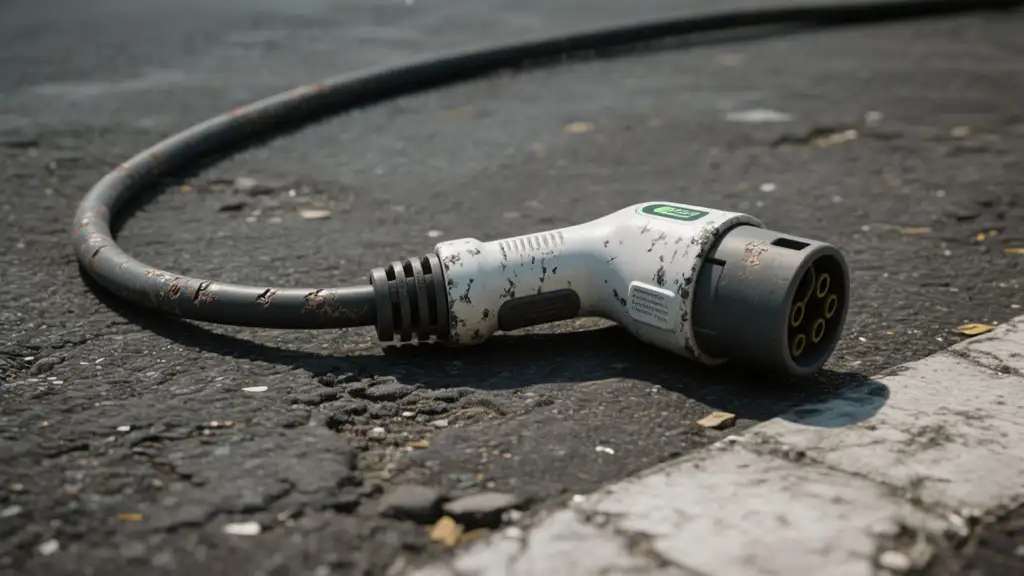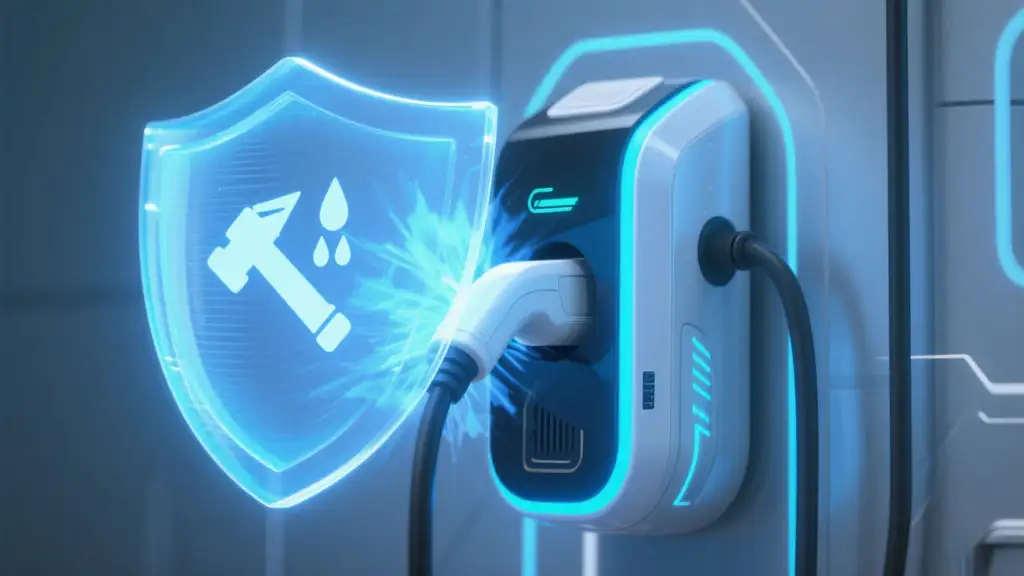What is the Lifespan of an EV Charger? An EV charger, known technically as Electric Vehicle Supply Equipment (EVSE), should last for about 10 years. However, this is not a guarantee. The true EV charger lifespan depends heavily on its type, build quality, usage, and environment. A well-maintained, high-quality home charger used in a mild climate might last over a decade, while a heavily used public charger in a harsh environment may need major repairs or replacement in as little as 5 to 7 years.
This guide will break down everything you need to know. We will cover the factors that determine durability, specific advice for homeowners and businesses, and the warning signs that your charger is failing. Our goal is to give you the confidence to choose a charger that will be a reliable partner for your electric vehicle for years to come.
| Charger Type | Voltage | Typical Use Case | Average Lifespan | Key Considerations |
|---|---|---|---|---|
| Level 1 | 120V | Home (Standard Outlet), Emergency | 10+ Years | Simple Electronics, Low Stress, But Very Slow Charging |
| Level 2 | 240V | Home, Workplace, Public Parking | 5-10 Years | The Most Common Type. Lifespan Is Highly Variable Based On Quality And Use |
| DC Fast Charger (DCFC) | 480V+ | Public Highway Corridors, Fleets | 7-10+ Years | Highly Complex, Requires Professional Maintenance. Key Components May Have Shorter Lifespans |
Why does one charger last 5 years while another lasts 12? The answer lies in these seven critical factors.
The quality of internal parts is the single most important factor. Reputable manufacturers use higher-grade relays, contactors, and circuit boards that can withstand thousands of charging cycles. Look for chargers that have been certified by a Nationally Recognized Testing Laboratory like Underwriters Laboratories (UL) або Intertek (ETL). According to UL, their certification means the charger has been tested to meet rigorous safety and durability standards. This non-negotiable certification ensures the product has been properly designed and manufactured.
Where you install your charger matters immensely.
Weather: Extreme heat can degrade electronics over time, while extreme cold can make cables brittle. A 2022 study from the Idaho National Laboratory highlighted how temperature affects charging performance, which also relates to component stress.
Moisture & Salinity: Humidity, rain, and salty air in coastal regions can corrode electrical contacts.
Protection: Always check the charger’s NEMA (National Electrical Manufacturers Association) rating. A NEMA 3R enclosure is suitable for outdoor use and protects against rain and sleet. For locations with hose-directed water or high dust, a NEMA 4 rating offers superior protection.
A charger at a single-family home used once daily experiences far less wear than a public charger at a busy shopping mall used 20 times a day. The constant cycling of power puts stress on the internal contactors. According to the Open Charge Alliance, which governs the EV Charging Standards protocol OCPP, high-use chargers require more robust management and monitoring systems to ensure reliability.

Poor installation is a primary cause of premature charger failure. The National Electrical Code (NEC) has specific requirements for EVSE installation. A professional electrician ensures:
The circuit breaker is correctly sized.
The wiring gauge is appropriate for the load.
All connections are secure to prevent overheating.
The unit is properly grounded.
A faulty installation not only voids the warranty but is a serious fire hazard, a warning echoed by the National Fire Protection Association (NFPA).
Your charger’s sensitive electronics are vulnerable to power grid fluctuations. Power surges from lightning strikes or utility switching can instantly destroy a charger’s circuit board. Installing an EV Charger Surge Protector is a small investment that provides a critical layer of defense for your more expensive charging unit.
Modern smart chargers rely on software to manage charging sessions, connect to apps, and optimize energy use. A charger from a manufacturer that provides regular over-the-air (OTA) firmware updates has a longer “useful” life. These updates can fix bugs, improve performance, and add new features, keeping the hardware relevant for longer.
The most handled parts of a charger are the most likely to fail.
Cables: Repeatedly bending, twisting, or driving over the charging cable will cause it to fray and fail.
Connectors: У "The charger connector types, like the J1772 or NACS (Tesla) plug, can be damaged if dropped, improperly inserted, or exposed to dirt and moisture. Connector failure is a common and costly repair.
For most homeowners, an EV charger is a significant purchase. You expect it to work flawlessly for years. Here’s how to make that happen.
When shopping, look beyond the price tag. Focus on:
Brand Reputation: Choose brands known for reliability, such as ChargePoint, Wallbox, or JuiceBox.
Warranty: A 3-year warranty is a strong indicator of the manufacturer’s confidence in their product, compared to a standard 1-year warranty.
Outdoor Rating: Even for a garage installation, a robust NEMA rating indicates better build quality.
Cable Quality: Check for a thick, sturdy, and flexible cable that feels durable.
|
Task |
Frequency |
Why It’s Important |
|
Visual Inspection |
Monthly |
Check cable for cracks or frays. Check the connector for bent pins or debris. |
|
Keep It Clean |
Quarterly |
Wipe down the unit and cable with a damp cloth to remove dust and grime. |
|
Check Connections |
Annually |
Ensure the charger is still securely mounted to the wall. |
|
Test GFCI |
Monthly |
Press the “Test” button on the plug (if applicable) to ensure the safety circuit works. |

For a business, a charger is a revenue-generating asset or a critical piece of operational equipment. Uptime is everything.
Commercial chargers are built differently. They feature tougher steel or aluminum bodies, thicker cables, and often have cable-retraction systems to prevent damage. An effective EV Charging Station Design is crucial. It should protect the units from vehicle impacts with bollards and place them for easy, safe access. The overall charging station cost should be viewed as a Total Cost of Ownership (TCO), where a higher initial price for a durable unit leads to lower maintenance and replacement costs later.
A service and maintenance agreement is essential for commercial chargers. According to a report from BloombergNEF, charger reliability is a major concern for EV adoption, and proactive maintenance is the key solution. This plan should include:
Regular physical inspections by qualified technicians.
Remote monitoring to track usage and detect errors in real-time.
Firmware updates to keep the system secure and efficient.
Guaranteed response times for repairs to minimize downtime.
For operations in colder climates, investing in Extreme Cold EV Charging Solutions like heated cables or insulated enclosures can prevent weather-related failures and ensure consistent service.
Even the best chargers can fail. Watch for these common warning signs.
Charging Faults: The charger or your vehicle frequently reports a charging error.
Reduced Speed: A Level 2 charge that used to take 6 hours now takes 9.
Overheating: The charger unit or plug handle becomes unusually hot to the touch.
Unusual Noises: A loud humming or clicking sound during operation.
Physical Damage: Cracks in the casing, exposed wires, or a broken connector latch.
Tripped Breakers: The charger repeatedly trips the circuit breaker.
If you notice these signs, first try basic troubleshooting: reboot the charger (by flipping the circuit breaker off and on) and inspect for visible damage. If the problem persists, stop using the unit and contact a qualified electrician or the manufacturer’s support line.
An EV charger lifespan of around 10 years is a realistic expectation, but only if you make smart choices. It begins with selecting a certified, high-quality unit from a reputable brand. It continues with professional installation, which is non-negotiable for safety and reliability. Finally, through simple maintenance and by protecting it from the elements, you can ensure your charger remains a dependable part of your electric driving experience for its full expected life. Treat it not as a simple appliance, but as a long-term investment in your transportation future.
Choosing the right charger means investing in durability you can trust. As an industry leader, linkpowercharging engineers chargers built to last. Our products feature a top-tier IK10 impact protection rating, capable of withstanding significant collisions, and an IP65 waterproof rating, ensuring flawless operation even in heavy rainstorms. This robust construction, backed by a comprehensive 3-year warranty, goes beyond industry standards to significantly extend your EV charger’s lifespan. For a charging solution that offers true peace of mind and long-term reliability, choose linkpowercharging and power your future with confidence.To learn more, feel free to contact our specialists
U.S. Department of Energy, Alternative Fuels Data Center – “Developing Infrastructure to Charge Plug-In Electric Vehicles” https://afdc.energy.gov/fuels/electricity_infrastructure.html
UL Standards – “UL 2594: Standard for Electric Vehicle Supply Equipment” https://www.ul.com/standards/ul-2594
National Fire Protection Association – “NFPA 70, National Electrical Code®” https://www.nfpa.org/codes-and-standards/all-codes-and-standards/list-of-codes-and-standards/detail?code=70
Idaho National Laboratory – “Real-World Electric Vehicle Charging Data” https://www.inl.gov/article/real-world-electric-vehicle-charging-data/
Open Charge Alliance – “About OCPP” https://www.openchargealliance.org/about-us/about-ocpp/
Ми надішлемо вам детальну технічну інформацію та пропозицію!